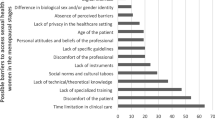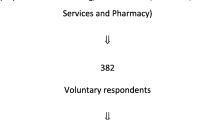Abstract
The aim of this study was to assess the practice of members of the British Society of Urogynaecology (BSUG) with respect to female sexual dysfunction (FSD) and compare it to members of the American Urogynecologic Society (AUGS). A web-based anonymous electronic questionnaire was sent to all (n = 150) BSUG members. Frequencies of responses and chi-square test for association with demographics were calculated. One hundred questionnaires were returned of which 95 were sufficiently filled. Fifty percent regularly screened for FSD at clinic visits and 49.5% after surgery, compared to 77% and 76% of AUGS members, respectively. The most important barrier was lack of time. Only 2% said FSD was not an important problem. Seventy-six percent found training for FSD unsatisfactory. FSD is not part of normal practice for half of BSUG members. There is, therefore, a need for better implementation of education and training at both undergraduate and postgraduate levels.

Similar content being viewed by others
References
Basson R, Berman J, Burnett A, Derogatis L, Ferguson D, Fourcroy J et al (2000) Report of the international consensus development conference on female sexual dysfunction: definitions and classifications. J Urol 163:888–893
Mercer CH, Fenton KA, Johnson AM, Wellings K, Macdowall W, McManus S et al (2003) Sexual function problems and help seeking behaviour in Britain: national probability sample survey. BMJ 327:426–427
Berman L, Berman J, Felder S, Pollets D, Chhabra S, Miles M et al (2003) Seeking help for sexual function complaints: what gynecologists need to know about the female patient’s experience. Fertil Steril 79:572–576
Geiss IM, Umek WH, Dungl A, Sam C, Riss P, Hanzal E (2003) Prevalence of female sexual dysfunction in gynecologic and urogynecologic patients according to the international consensus classification. Urology 62:514–518
Pauls RN, Segal JL, Andre Silva W et al (2006) Sexual function in patients presenting to a urogynecology practice. Int Urogynecol J Pelvic Floor Dysfunct 17:576–80
Ghielmetti T, Kuhn P, Dreher EF et al (2006) Gynaecological operations: do they improve sexual life? Eur J Obstet Gynecol Reprod Biol 129:104–110
Pauls RN, Kleeman SD, Segal JL et al (2005) Practice patterns of physician members of the American Urogynecologic Society regarding female sexual dysfunction: results of a national survey. Int Urogynecol J 16:460–467
Handa VL, Harvey L, Cundiff GW et al (2004) Sexual function among women with urinary incontinence and pelvic organ prolapse. Am J Obstet Gynecol 191:751–6
Özel B, White T, Urwitz-Lane R et al (2005) The impact of pelvic organ prolpase on sexual function in women with urinary incontinence. Int Urogynecol J 17:14–17
Novi JM, Jeronis S, Morgan MA et al (2005) Sexual function in women with pelvic organ prolapse compared to women without pelvic organ prolapse. J Urol 173:1669–1672
Handa VL, Cundiff G, Chang HH et al (2008) Female sexual function and pelvic floor disorders. Obstet Gynecol 111:1045–1052
Plouffe L Jr (1985) Screening for sexual problems through a simple questionnaire. Am J Obstet Gynecol 151:166–168
Safarinejad MR (2006) Female sexual dysfunction in a population-based study in Iran: prevalence and associated risk factors. Int J Impot Res 18:382–395
Elnashar AM, El-Dien Ibrahim M, El-Desoky MM et al (2007) Female sexual dysfunction in Lower Egypt. BJOG 114:201–206
Abdo CHN, Oliveira WM Jr, Moreira ED Jr et al (2004) Prevalence of sexual dysfunctions and correlated conditions in a sample of Brazilian women—results of the Brazilian study on sexual behaviour (BSSB). Int J Impot Res 16:160–166
Wendt E, Hildingh C, Lidell E et al (2007) Young women’s sexual health and their views on dialogue with health professionals. Acta Obstet Gynecol Scand 86:590–595
Conflicts of interest
None.
Author information
Authors and Affiliations
Corresponding author
Appendix 1
Appendix 1







Rights and permissions
About this article
Cite this article
Roos, AM., Thakar, R., Sultan, A.H. et al. Female sexual dysfunction: are urogynecologists ready for it?. Int Urogynecol J 20, 89–101 (2009). https://doi.org/10.1007/s00192-008-0735-3
Received:
Accepted:
Published:
Issue Date:
DOI: https://doi.org/10.1007/s00192-008-0735-3




